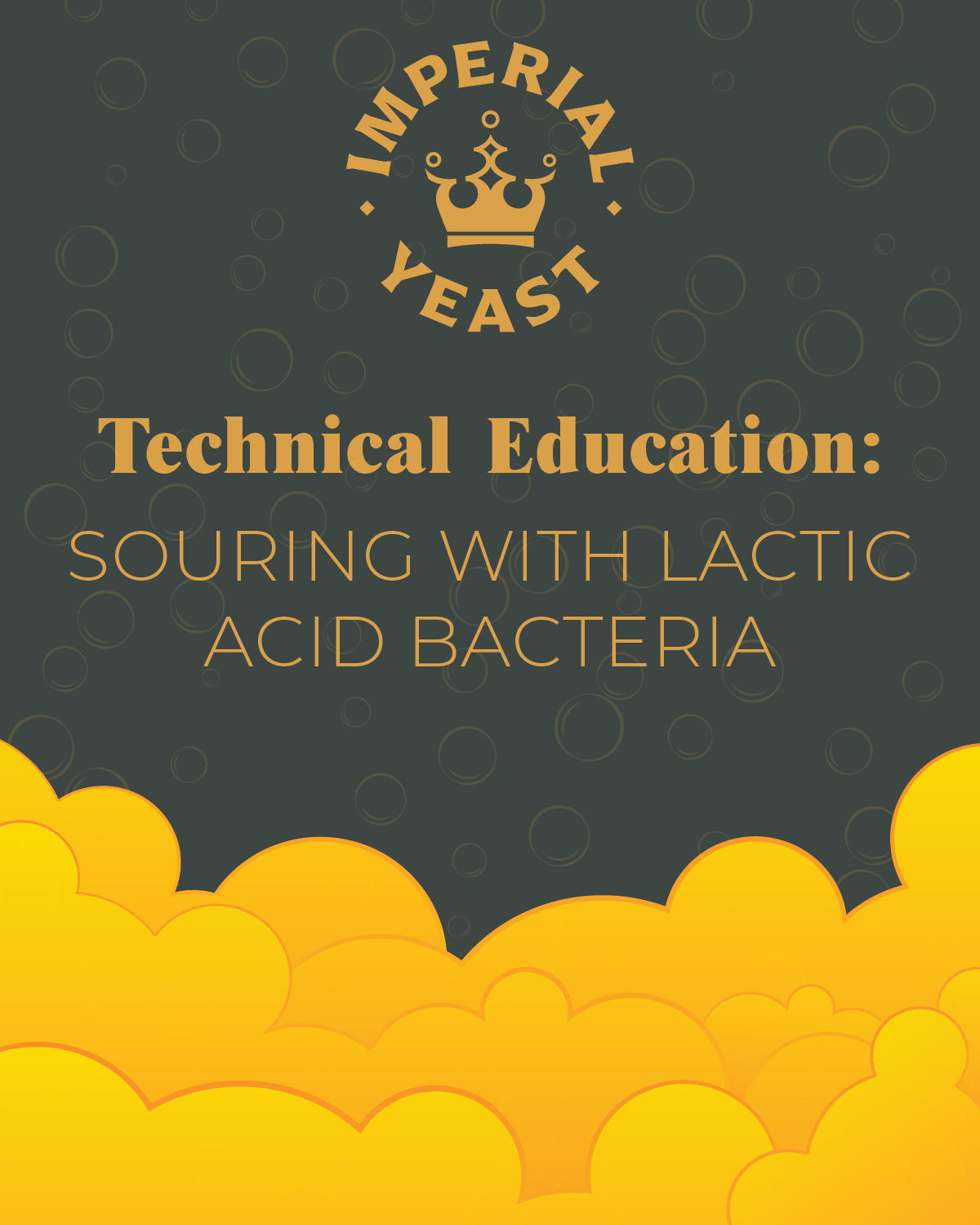There has been an increase in the popularity of sour beers within the last five to ten years. Traditional sour beers typically include the addition of Brettanomyces, as well as lactic acid and acetic acid producing bacteria. However, the long fermentation times and inconsistent results of these styles often render them unrealistic for most breweries. Alternatively, modern methods to sour beer production have been developed and are utilized industry-wide in response to the necessity for quick, consistent and controllable fermentation.
Two primary methods for sour beer production are commonly employed today. Both methods include inoculation with a pure culture of lactic acid producing bacteria (LAB) in the pre-fermentation stages, followed by a primary ethanol fermentation using Saccharomyces. The first method is referred to as “Kettle Souring,” which involves boiling as a means of pasteurization. The second method does not include boiling. Both methods include specific approaches and sets of considerations, which will be further discussed here.
Sour Beers
Sour beers are often characterized by the taste of lactic acid, a metabolite of lactic acid-producing bacteria (LAB) used in the fermentation process. They have a terminal pH range of 3.3-3.9 and a lactic acid content of around 3-6g/L. While most traditional beers, i.e. ales and lagers, are fermented with a single strain of yeast, sour beers are often inoculated with both lactic acid producing bacteria and yeast.
Typically, the bacteria used in sour beer production is a species of Lactobacillus. Lactobacilli are gram-positive rod-shaped bacteria that produce lactic acid as a byproduct of carbohydrate metabolism. L. brevis, commercially available as Imperial Yeast’s W25, is a strain commonly selected due to its relatively high stress tolerance and low production of off-flavored metabolites such as diacetyl.
Pitching Sequence Matters
Numerous studies have shown that pitching LAB prior to yeast fermentation mitigates the negative stresses of ethanol and hop derived compounds on the bacteria. Additionally, only pre-fermentation pitch sequences, in the absence of yeast, have been shown to drop pH levels to <3.9 and contain as much as 6g/L of lactic acid within a 48-hour period (Ciosek, Poreda & Rusiecka, 2019). The rapid drop in pH and the beginning of ethanol fermentation with Saccharomyces within 48 hours is essential for mitigating the risk of contamination by other beer spoiler microorganisms.
Methods of Pre-Fermentation Pitch Sequences
Kettle Souring
This method involves souring within a vessel, typically a brewhouse kettle, that allows for boiling as a means of pasteurization before primary ethanol fermentation. This process is suited for brewers that are concerned with contamination of brewery equipment with lactobacillus. The combination of boiling and hop additions significantly lowers the possibility of the survival of Lactobacillus downstream. A drawback to this method is volatilizing flavor and aroma active compounds that provide the dimensional characteristics of Lactobacillus fermentations (i.e. esters, higher alcohols, aldehydes, ketones, etc.). (Dysvik, Liland, 2019).
Kettle Souring Process:
- Transfer collected wort from mash/lauter tun to a cleaned and sanitized kettle as typical.
- Boil the unhopped wort for around 30-60 minutes for hot break formation and complete pasteurization.
- After the boil, mix as well as possible to homogenize the wort while cooling to a target inoculation temperature of 85-95°F.
- Adjust starting wort pH to 4.6 or lower using lactic acid or phosphoric acid.
- If using a pure culture of Lactobacillus, apply CO2 at a low psi through the bottom port of the kettle. This further purges O2 and creates a continuous “CO2 blanket” that discourages growth of aerobic spoilers.
- Inoculate the wort with Lactobacillus in the kettle at a pitch rate of 1L/BBL while at 85-95°F.
- Allow a minimum of 24-48 hours to reach terminal pH, usually dropping to around 3.4pH.
- Monitor gravity and pH at 24 hours and track progress.
- After the target pH is reached, re-boil the wort. While boiling, add nutrients as usual and aerate during knockout for primary yeast fermentation.
- Once in the fermentation vessel, inoculate with Saccharomyces strain tolerant of low pH environments at target pitch rate.
Pre-Fermentation in a Fermentation Vessel (FV)
The method of direct souring in the fermentation vessel is for brewers who can confidently manage the contamination risk and/or are seeking diverse and complex character from Lactobacillus pre-fermentation. The process is similar to non-sour wort production, with a few exceptions.
The primary exceptions are the use of hops and aeration during knockout. Hops are strongly discouraged as the iso-a-acids will inhibit the growth of many Lactobacillus strains. If hops are preferred, then it is advised to perform a kettle sour where hops are boiled after souring, or to blend with hopped wort after souring. Additionally, to discourage the growth of aerobic spoilage organisms, aerating during knockout is not recommended.
FV Souring Process:
- After the wort is collected from the mash/lauter tun it is left unhopped and boiled for around 30-60 minutes for complete pasteurization.
- Adjust starting wort pH to 4.6 or lower using lactic acid or phosphoric acid; nutrient is often omitted.
- After the boil, transfer the cooled wort at 85-95°F to a cleaned and sanitized FV that has been purged with CO2.
- Inoculate the wort with a pure culture of Lactobacillus at a rate of 1L/BBL.
- Allow a minimum of 24-48 hours to reach terminal pH, usually dropping to around 3.4pH.
- Monitor gravity and pH at 24 hours and track progress.
- Once terminal pH is achieved, cool the wort to strain-appropriate fermentation temperatures.
- Aerate at 1LPM for 1-2 minutes per barrel prior to inoculation.
- Inoculate with Saccharomyces strain tolerant of low pH environments at target pitch rate.
